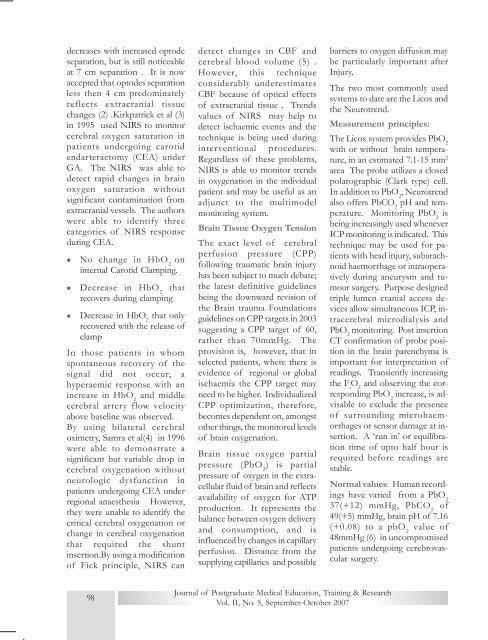National Board Ex- 6 Book .pmd - National Board Of Examination
National Board Ex- 6 Book .pmd - National Board Of Examination
National Board Ex- 6 Book .pmd - National Board Of Examination
Create successful ePaper yourself
Turn your PDF publications into a flip-book with our unique Google optimized e-Paper software.
decreases with increased optodeseparation, but is still noticeableat 7 cm separation . It is nowaccepted that optodes separationless then 4 cm predominatelyreflects extracranial tissuechanges (2) .Kirkpatrick et al (3)in 1995 used NIRS to monitorcerebral oxygen saturation inpatients undergoing carotidendarteractomy (CEA) underGA. The NIRS was able todetect rapid changes in brainoxygen saturation withoutsignificant contamination fromextracranial vessels. The authorswere able to identify threecategories of NIRS responseduring CEA.llNo change in HbO 2oninternal Carotid Clamping.Decrease in HbO 2thatrecovers during clampingl Decrease in HbO 2that onlyrecovered with the release ofclampIn those patients in whomspontaneous recovery of thesignal did not occur, ahyperaemic response with anincrease in HbO 2and middlecerebral artery flow velocityabove baseline was observed.By using bilateral cerebraloximetry, Samra et al(4) in 1996were able to demonstrate asignificant but variable drop incerebral oxygenation withoutneurologic dysfunction inpatients undergoing CEA underregional anaesthesia However,they were unable to identify thecritical cerebral oxygenation orchange in cerebral oxygenationthat required the shuntinsertion.By using a modificationof Fick principle, NIRS candetect changes in CBF andcerebral blood volume (5) .However, this techniqueconsiderably underestimatesCBF because of optical effectsof extracranial tissue . Trendsvalues of NIRS may help todetect ischaemic events and thetechnique is being used duringinterventional procedures.Regardless of these problems,NIRS is able to monitor trendsin oxygenation in the individualpatient and may be useful as anadjunct to the multimodelmonitoring system.Brain Tissue Oxygen TensionThe exact level of cerebralperfusion pressure (CPP)following traumatic brain injuryhas been subject to much debate;the latest definitive guidelinesbeing the downward revision ofthe Brain trauma Foundationsguidelines on CPP targets in 2003suggesting a CPP target of 60,rather than 70mmHg. Theprovision is, however, that inselected patients, where there isevidence of regional or globalischaemia the CPP target mayneed to be higher. IndividualizedCPP optimization, therefore,becomes dependent on, amongstother things, the monitored levelsof brain oxygenation.Brain tissue oxygen partialpressure (PbO 2) is partialpressure of oxygen in the extracellularfluid of brain and reflectsavailability of oxygen for ATPproduction. It represents thebalance between oxygen deliveryand consumption, and isinfluenced by changes in capillaryperfusion. Distance from thesupplying capillaries and possiblebarriers to oxygen diffusion maybe particularly important afterInjury.The two most commonly usedsystems to date are the Licox andthe Neurotrend.Measurement principles:The Licox system provides PbO 2with or without brain temperature,in an estimated 7.1-15 mm 2area The probe utilizes a closedpolarographic (Clark type) cell.In addition to PbO 2, Neurotrendalso offers PbCO 2pH and temperature.Monitoring PbO 2isbeing increasingly used wheneverICP monitoring is indicated. Thistechnique may be used for patientswith head injury, subarachnoidhaemorrhage or intraoperativelyduring aneurysm and tumoursurgery. Purpose designedtriple lumen cranial access devicesallow simultaneous ICP, intracerebralmicrodialysis andPbO 2monitoring. Post insertionCT confirmation of probe positionin the brain parenchyma isimportant for interpretation ofreadings. Transiently increasingthe F iO 2and observing the correspondingPbO 2increase, is advisableto exclude the presenceof surrounding microhaemorrhagesor sensor damage at insertion.A ‘run in’ or equilibrationtime of upto half hour isrequired before readings arestable.Normal values: Human recordingshave varied from a PbO 237(+12) mmHg, PbCO 2of49(+5) mmHg, brain pH of 7.16(+0.08) to a pbO 2value of48mmHg (6) in uncompromisedpatients undergoing cerebrovascularsurgery.98Journal of Postgraduate Medical Education, Training & ResearchVol. II, No. 5, September-October 2007
















